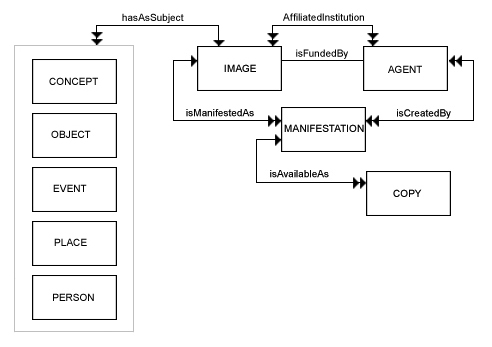IAP Model
From DigiRepWiki
Contents |
Introduction
The IAP has renamed the FRBR Work entity as ‘Image’. This has been done (a) to avoid confusion between notions of Work as described traditionally in image cataloguing in the cultural sector (i.e. the physical thing) and abstract Work as described in FRBR, and (b) to emphasise that the digital image itself is at the centre of the IAP model.
One area where we had particular concerns with FRBR for images was in the notion of an abstract Expression layer in the model. This entity, while very useful in describing the various intellectual and artistic realisations of textual, musical and performance works, was not, it seemed to us, as useful in describing images, as defined in our project scope. In FRBR the Expression points to ‘intellectual’ differences, which are not always apparent to the same extent in, for instance, a format change in an image. To this end we have omitted this entity from the IAP model.
The IAP Model also makes use of the FRBR Group 3 Entities: Concept (an abstract notion or idea), Object (a material thing), Event (an action or occurrence) or Place (location), which will facilitate simple keyword searching of images. We also added to the FRBR recommendations for subject a Person Entity that we felt was necessary to express either the creator of the object depicted in the image, or a person who appears in the image. This Person information is distinct from FRBR Group 2 Entities which we have followed SWAP in consolidating as a single Agent. In the IAP Agent is typically a funder, associated institution, or the creator of an image Manifestation. Similarly the IAP follows SWAP in its use of Copy instead of FRBR Item. Here a Copy is typically a network location of a particular image Manifestation.
In natural language what this model says is that each Image can have one or more Manifestations, and each Manifestation can be made available as one or more Copies. Each Image can have one or more Subjects, Objects, Events, Places or People associated with it. Each Image can have one or more funders and affiliated institutions and each funder and affiliated institution can be associated with one or more Image. And each Manifestation can have one or more Creator, and each Creator can be associated with one or more Manifestations.
To use the Angel of the North example in the IAP Model:
i¹ An image depicting The Angel of the North as seen at the Great North Run
c¹ sculpture
o¹ The Angel of the North
pl¹ Gateshead
pe¹ Gormly, Anthony
e¹ The great north run
m¹ image in TIFF Format
m² image in RAW Format
Model
Attributes
The attributes we use to describe each of our entities are summarised below. In addition to Dublin Core and FRBR, the other metadata schema standards we looked at that have particular application for images were the Visual Resources Association (VRA) Core 4, Catalogue Descriptions for Works of Art (CDWA) and Metadata for Images in XML (MIX / NISO Z39.87). In the end we used a combination of MIX for technical information relating to the various manifestations, DC and the FRBR subject entities as described above. We also looked at EXIF and ITPC standards and their recent developments, and recommend that, where possible, repositories enable automated population of the technical fields using them.
As well as the standard fields derived from FRBR, DC and MIX, we introduced an ‘isDescribedBy’ property of Image which is intended, via an identifier such as a URI, to point to a fuller metadata record where available, that describes the image and its context in more detail. Also, the isPartOf property of Image is intended to point to the larger image collection in which the single image belongs. The use of these properties is intended to facilitate the inclusion of more detailed information about the images, their context, objects and relationships while keeping the Profile relatively uncomplicated. Two further new properties that came out of our use case analysis were ‘relatedCourse’ property of Manifestation, designed to include information about related courses where the image manifestation appears and reproductionCost as a property of Copy, which will give the end-user a cost price for various types of publication. We have yet to make a final decision as to whether these attributes remain in project scope. One idea is to relate the course information property to the work going on in the XCRI Project, but this will require some further research. The reproductionCost attribute seems appropriate if institutions intend to generate revenue from image publication.
Image
Identifier entityType hasAsSubject isDescribedBy isManifestAs isPartOf Title Description Source Subject Funder Grant Number
Manifestation
Identifier entityType isCreatedBy Format Extent dateCreation colorSpace bitDepth Orientation Resolution changeHistory isAvailableAs
Copy
Identifier entityType accessRights dateAvailable termsOfUse reproductionCost
Agent
Identifier entityType Name familyName Role Contact Homepage
Subject Object
Object
Subject Place
Place
Subject Concept
Concept
Subject Event
Event
Subject Person
Person personRole


